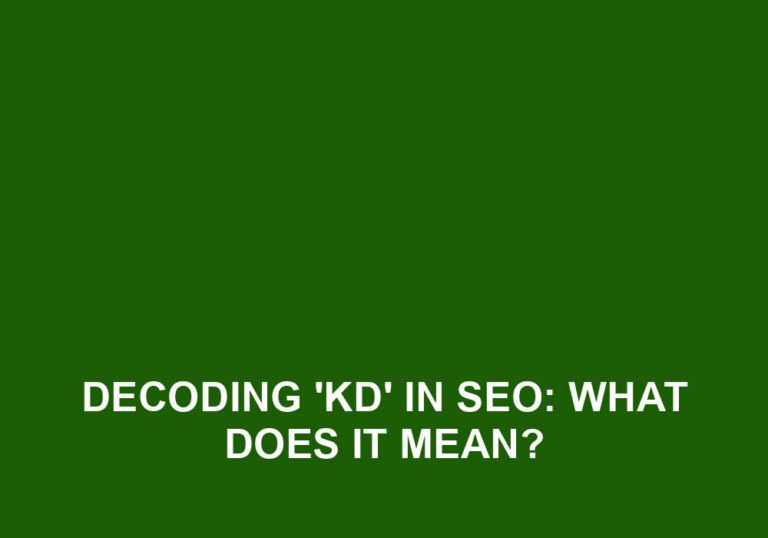In the vast digital landscape, where attention spans are shrinking and competition for visibility is fierce, every word counts. As a website owner or content creator, you may have heard about the importance of meta descriptions in improving search engine rankings and attracting users to click through to your website. But have you ever wondered just how many characters you should aim for in your meta descriptions to strike the perfect balance between providing valuable information and captivating your audience? In this article, we will delve into the ideal character count for meta descriptions in the English language, equipping you with the knowledge to craft compelling and concise snippets that leave a lasting impact.
Meta descriptions are the brief yet powerful snippets of text that appear beneath a website’s title in search engine results pages. They act as enticing previews, giving users a glimpse into the content that awaits them if they choose to click. But with limited space available, it is crucial to make every character count. While there is no fixed character limit for meta descriptions, experts recommend keeping them between 135 to 160 characters to ensure optimal display across different devices and search engines. Striking the right balance between brevity and relevance is key, as you want to entice users with a concise summary while ensuring that your message remains intact. In this article, we will explore the factors to consider when crafting meta descriptions, tips for maximizing their impact, and the potential consequences of exceeding the recommended character count. So, let’s dive in and unravel the mysteries of creating captivating meta descriptions that drive engagement and increase your website’s visibility in the vast digital realm.
Meta Description Character Limit: The recommended character limit for a meta description is between 50 and 160 characters. This is because search engines typically display around 50-70 characters. Keep your meta description concise and compelling to encourage users to click on your website in search results.
How Many Characters in a Meta Description?
When it comes to optimizing your website for search engines, writing an effective meta description is crucial. A meta description is a brief summary of your webpage’s content that appears in search engine results. It not only gives users a glimpse of what they can expect from your page but also plays a role in improving your website’s click-through rate. However, it’s important to understand the character limit for a meta description to ensure that it is displayed correctly across different search engines.
Character Limit for Meta Descriptions
Google recommends keeping meta descriptions between 50 and 160 characters in length. While this is the general guideline, it’s crucial to note that search engines may truncate meta descriptions that exceed the recommended character limit. If a meta description is too long, search engines will cut it off, and users will only see a portion of it in the search results. On the other hand, if a meta description is too short, it may not provide enough information to entice users to click on your website. Therefore, it’s essential to strike the right balance and make every character count.
To ensure that your meta description fits within the character limit, you can use various online tools or text editors that provide a character count feature. These tools allow you to input your meta description and instantly see the number of characters used. Additionally, some content management systems and SEO plugins have built-in character counters that can help you keep track of your meta description length as you write it.
Best Practices for Writing Meta Descriptions
Now that you know the character limit for meta descriptions, let’s dive into some best practices for writing compelling and effective meta descriptions:
1. Be concise and specific: Use concise language to describe the content of your webpage accurately. Be specific about what users can expect when they click on your link.
2. Include relevant keywords: Incorporate relevant keywords into your meta description to improve the visibility of your webpage in search results. However, avoid keyword stuffing, as it can harm your website’s ranking.
3. Use a call-to-action: Encourage users to click on your link by including a compelling call-to-action in your meta description. This can increase the likelihood of users visiting your webpage.
4. Highlight unique selling points: If your webpage offers something unique or stands out from competitors, mention it in your meta description to entice users to choose your link over others.
5. Keep it relevant: Ensure that your meta description accurately reflects the content of your webpage. Misleading or unrelated meta descriptions can lead to a higher bounce rate and negatively impact your website’s reputation.
By following these best practices and staying within the recommended character limit, you can create compelling meta descriptions that effectively promote your webpages and improve click-through rates.
Remember, meta descriptions are the first impression of your webpage in search engine results, so make sure to invest time and effort into crafting them carefully.
Frequently Asked Questions
Here is a list of commonly asked questions about the number of characters in a meta description:
How many characters should a meta description have?
A meta description should ideally have a maximum of 155-160 characters. This limit ensures that the entire description is visible on search engine results pages (SERPs) and prevents it from being truncated. However, keep in mind that search engines do not use character count as a ranking factor, so it’s more important to focus on creating a compelling and concise description that accurately represents the content of the page.
Having a meta description that is too long may result in search engines cutting off the text, making it less effective in conveying the intended message to users. On the other hand, having a meta description that is too short could miss out on opportunities to entice users to click on your page. Therefore, it’s crucial to strike a balance and make every character count.
What happens if the meta description exceeds the character limit?
If a meta description exceeds the recommended character limit of 155-160 characters, search engines will truncate it by adding an ellipsis (…) at the end. This truncation can potentially impact the readability and effectiveness of the description, as important information may be cut off. Users may not get a complete understanding of the page’s content, which could result in lower click-through rates.
While search engines may truncate a meta description, it’s essential to keep in mind that the actual character limit may vary across different search engines and devices. Therefore, it’s best to aim for a concise and compelling meta description that accurately represents the page’s content within the recommended character limit.
Does Google count meta description characters differently?
Google truncates meta descriptions based on pixel width rather than character count. This means that if a meta description contains wider characters (such as “W” or “M”), it may reach the pixel width limit before reaching the character limit. On the other hand, narrower characters (such as “i” or “l”) allow for more characters to fit within the pixel width limit.
It’s important to note that Google’s pixel width limit for meta descriptions is typically around 920 pixels. However, this limit may change over time due to updates in search engine algorithms and user interface changes. Therefore, it’s always a good practice to aim for a concise meta description that accurately represents the page’s content and fits within the pixel width limit to ensure optimal visibility on Google’s SERPs.
Can the meta description length affect SEO?
While the length of a meta description does not directly impact search engine optimization (SEO), it indirectly affects the click-through rate (CTR) of a webpage. A well-crafted, concise meta description that accurately describes the page’s content can entice users to click on the search result, leading to higher CTRs.
Higher CTRs can signal to search engines that the webpage is relevant and engaging, potentially improving its organic rankings. Therefore, although character count is not a ranking factor, optimizing the meta description length and content can indirectly contribute to SEO efforts by driving higher click-through rates and attracting more organic traffic.
Should I use the entire character limit for a meta description?
While the recommended character limit for a meta description is 155-160 characters, it’s not necessary to use the entire limit for every page. The key is to focus on creating a concise and compelling description that accurately represents the page’s content and entices users to click.
Using the entire character limit is not always feasible or necessary, as different pages have varying levels of complexity and information to convey. It’s more important to prioritize clarity and relevance over length. If a shorter meta description effectively captures the essence of the page, it may be more impactful than a longer one that includes unnecessary or repetitive information.
In conclusion, understanding the optimal length for a meta description is crucial for creating effective and engaging content. While there is no fixed character limit, it is generally recommended to keep meta descriptions between 150 and 160 characters. This range allows search engines to display the entire description in search results, while also providing enough space to entice users to click through to your website.
However, it is important to remember that character count is just one aspect of crafting a compelling meta description. Quality and relevance are equally important factors. By focusing on creating concise, informative, and persuasive descriptions that accurately reflect the content of your webpage, you can increase the likelihood of attracting more organic traffic and improving your website’s visibility in search engine results pages.
Ultimately, the goal of a meta description is to entice users to click on your website and engage with your content. By striking the right balance between character count and content quality, you can optimize your meta descriptions to effectively communicate your webpage’s value and drive more organic traffic to your site. So, take the time to craft engaging and informative descriptions that captivate your audience and leave a lasting impression.





